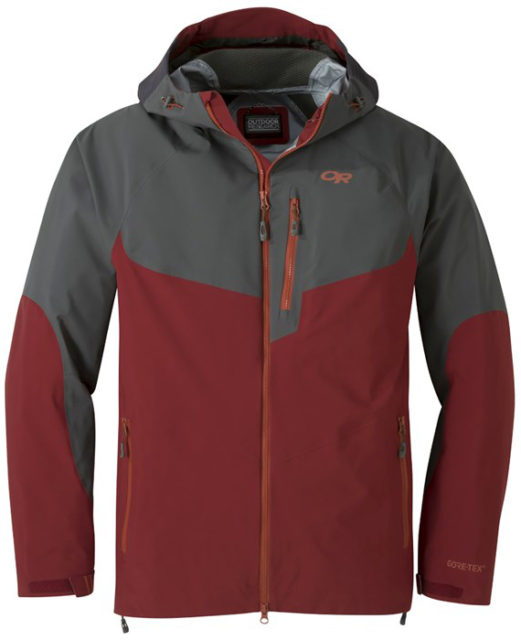
Outdoor Research Hemispheres Jacket
Reviewer: 5’8”, 155 lbs
Size Tested: Medium
Blister’s Measured Weight (size Medium): 544 g
Materials:
- Main Fabric: 3L Gore-Tex C-Knit w/ 70-denier nylon face fabric
- Underarms, Shoulders, Hood Panel: 2L Gore-Tex w/ Stretch Technology
Stated Features:
- Helmet Compatible Hood
- Wire-Brimmed Halo Hood
- YKK® AquaGuard® Zippers
- YKK® AquaGuard® Vislon Zippers
- TorsoFlo™ Venting – Hem-to-Pit
- Stretch Hood and Back Panels
- Double-Separating Center Front Zipper
- Hook/Loop Cuff Closures
- Elastic Drawcord Hem
Pockets:
- 2 handwarmer (zippered)
- 1 exterior chest (zippered)
- 1 interior chest (zippered)
- 2 interior drop-in
MSRP: $599
Test Locations: Cameron Pass & Telluride, CO
Days Tested: ~15
Intro
Gore-Tex has been around for almost 50 years. At its inception, Gore-Tex changed waterproof clothing forever. It was a waterproof fabric that also “breathed,” meaning that a notable amount of water vapor could pass through the fabric.
But a lot’s happened since 1969. Bell-bottom pants are no longer in vogue, several more people have walked on the moon, and the word “groovy” doesn’t get thrown around nearly as much (though I’ve just decided that I’m on a mission to change that last one).
And yet, Gore-Tex hasn’t changed all that much. They’ve made slight tweaks to the membrane and come out with updated laminates like Gore Pro and C-Knit, but the recipe for a Gore-Tex fabric has remained mostly the same: a Gore-Tex membrane laminated to one or two fairly stiff layers of fabric.
That was, until last year when Gore announced a new fabric: “Gore-Tex with Stretch Technology.” What this new fabric lacks in a sexy name it makes up for in intriguing specs — it can reportedly stretch up to 100% its size in two directions, which is far more stretch than pretty much any other waterproof fabric.
The new Outdoor Research Hemisphere’s jacket is one of the first outdoor-oriented products to use this new tech, and this jacket is aimed at backcountry skiers who prioritize freedom of movement and weather protection.
So just how revolutionary is the Hemispheres jacket and the new Gore-Tex fabric it employs?
Fit
Overall, the Hemispheres jacket’s fit is about average compared to most skiing shells, which I think makes sense given its stretchy fabric.
The Hemispheres jacket is much slimmer and a bit shorter than the Strafe Pyramid, Open Wear Open One, and Arc’teryx Sabre jackets. Compared to dedicated touring jackets like the Black Diamond Helio Active Shell and Norrona Lyngen Hybrid, the Hemisphere’s is notably roomier.
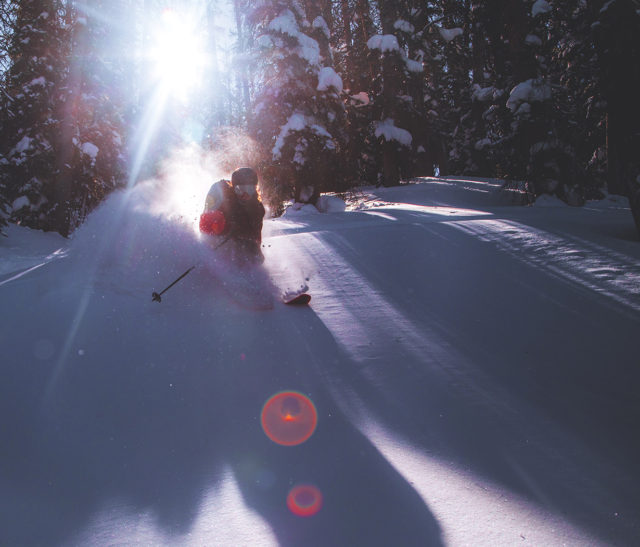
In the size Medium Hemispheres jacket, I have enough room to fit a midweight layer like the Patagonia Micro Puff Hoody with some room to spare (I’m 5’8”, 155 lbs).
While some companies accomplish freedom of movement and increased range of motion through roomy fits and intricate patterning, Outdoor Research takes a different approach with the Hemispheres jacket, which takes us to the next section.
Materials
The Hemispheres jacket is comprised primarily of a 70-denier Gore-Tex C-Knit fabric, which is similar to that on the Patagonia Refugitive, and a growing number of other shells that utilize Gore-Tex C-Knit.
But where the Hemispheres differs is in its panels around the underarms, hood, and shoulders. In these areas, it features Gore’s new stretch fabric. And that fabric is extremely stretchy.
In terms of elasticity, I’d put the Gore-Tex stretch fabric above any softshell I’ve used, and below a spandex material like those used on running leggings, ski-mountaineering suits, etc.
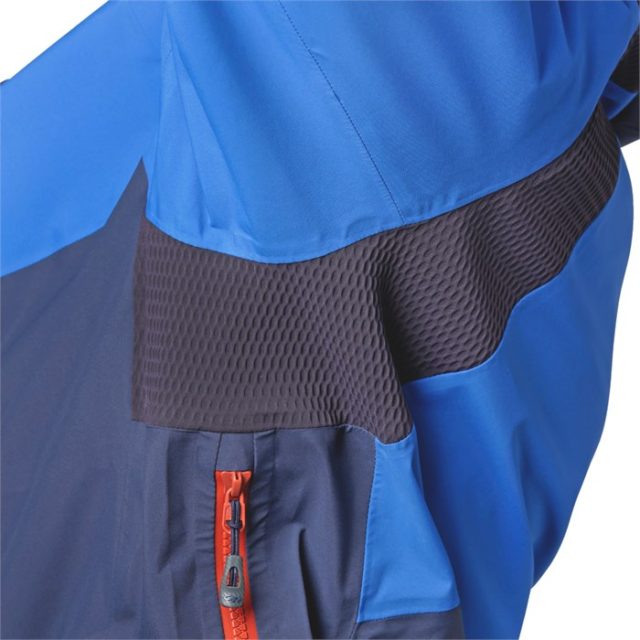
However, it’s important to note that we’re not talking about 4-way stretch. The Hemisphere’s stretch panels flex in two directions (i.e., along one axis), with little stretch in the other directions. As a result, Outdoor Research had to pattern the fabric specifically to maximize the functionality of the stretch fabric.
On the hood, the stretch panels stretch vertically, while the shoulder / underarm panels stretch horizontally (i.e., around your body). I’ll talk more about how this affects freedom of movement further down.
In terms of hand feel, the stretch fabric has a unique texture that’s almost honeycomb-like, and the backing side is pretty comfortable on skin, if a bit stickier than the main C-Knit fabric.
Speaking of the C-Knit fabric, it’s quite comfortable compared to traditional Gore-Tex or Gore Pro fabrics, and a bit stiffer than most Polartec NeoShell and softshell fabrics I’ve used. Of all the Gore-Tex fabrics I’ve used, C-Knit is my favorite when it comes to hand feel.
Features
For a shell designed for backcountry users, the Hemispheres jacket has a lot of features:
Pockets
There are five total pockets on the Hemispheres jacket.
Its two handwarmer pockets have ~20 cm zippers that make stuffing skins inside them difficult, but I can just barely fit a pair of Black Diamond Ultralite skins cut for the 180 cm Armada Tracer 108 inside. However, the handwarmer pockets get obstructed by all of my packs’ hipbelts, which makes accessing them while wearing a pack very difficult.
The Hemispheres jacket has one zippered exterior chest pocket. Inside that pocket there’s an interior mesh sleeve that can snugly fit an iPhone 6, but probably not anything wider (and it won’t fit a BCA Tracker 2 beacon). That said, it does securely hold a smaller phone, and there’s a headphone port on that pocket so you can route cords inside.
Inside the Hemispheres jacket are two mesh drop-in pockets that’ll fit a pair of goggles or gloves.
Lastly, there’s a zippered interior chest pocket that’s about the same size as the exterior one — a good size for a map, snacks, wallet, etc.
Vents
Due to the placement of the stretchy panels, the Hemispheres jacket does not have traditional pit-zip vents. Instead, it has 37 cm vents that run from the hem of the jacket up to where the stretch panel starts at the underarm.
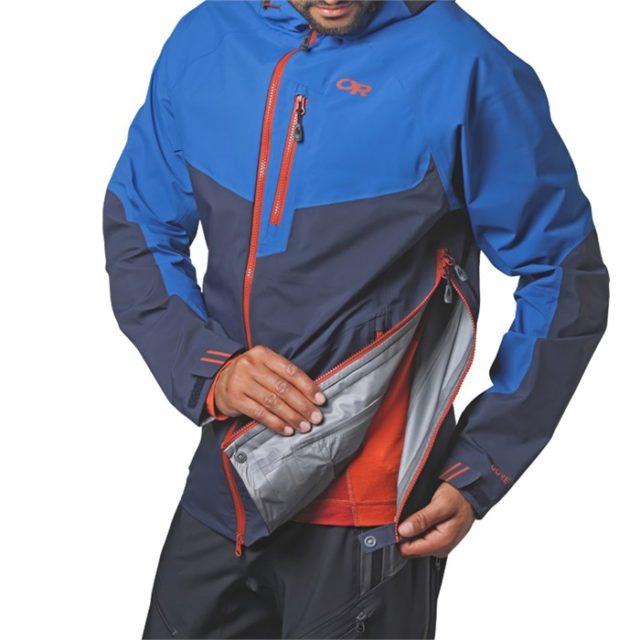
These vents feature two-way zippers so you can open the top or bottom. Functionally, I haven’t been a huge fan of these vents. Like the handwarmer pockets, the vents get covered by a pack’s hipbelt, and I feel like the Hemispheres’ vents don’t create as much airflow as traditional pit zips.
Hood
The Hemisphere’s three-way adjustable hood works very well on a bare head or beanie, and works well with most helmets. The stretchy panel on the hood helps it stretch to accommodate taller helmets, but since the fabric only stretches vertically, it feels a bit more restrictive than most other hoods I’ve used when looking to my left or right. I very rarely ski with my hood over my helmet so this doesn’t bother me, but it’s worth noting for people that do.
Cuffs
The Hemispheres’ velcro cuffs do their job. They can be snugged down nicely over a bare wrist, and can open up wide enough to go over most of my gloves (they can’t quite fit over gauntlet-style gloves like the Black Diamond Mercury Mitten).
Hem Adjustment
The Hemispheres jacket does not have a powder skirt. It does have a drawcord hem that works pretty well, though there have been a few occasions in deep snow where I got some snow up my back (the photo below being one of them). The hem’s drawcords are routed into the jacket’s handwarmer pockets, which I’m a fan of since I don’t like having a bunch of cords dangling around and getting in the way.
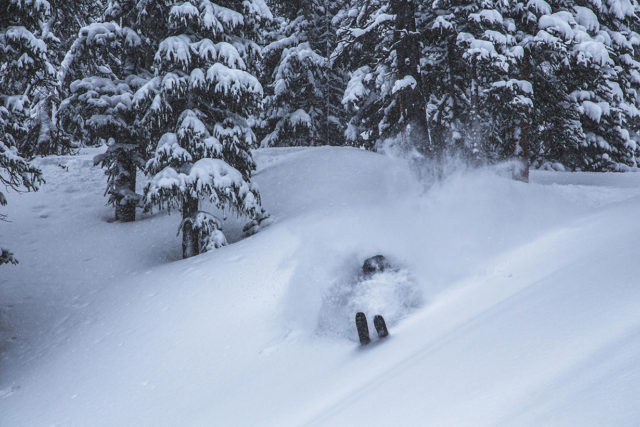
Main Zipper
The Hemispheres jacket has a ~76 cm, two-way YKK Vislon water-resistant main zipper. While it’s a bit more difficult to use than comparable one-way zippers, I’m personally on board with more jackets using two-way main zippers since it makes it easier to get to your pant pockets, harness, etc. This is definitely a personal preference thing, and some people may prefer the easier use of a one-way zipper.
Weight
Given how many features and pockets it has, the Hemispheres jacket is pretty light at 544 grams for a Medium.
Below is a list of our measured weights for several notable shells in this class (be sure to note the size differences to keep things apples-to-apples).
364 g Black Diamond Helio Active Shell, size Medium
518 g Flylow Cooper Jacket, size Medium
544 g Outdoor Research Hemispheres Jacket, size Medium
563 g Rab Sharp Edge Jacket, size Medium
590 g Flylow Higgins Coat 2.1, size Large
593 g Patagonia PowSlayer Jacket, size Large
605 g Patagonia Descensionist Jacket, size Medium
610 g Strafe Cham Jacket, size Large
841 g Strafe Pyramid Jacket, size Large
848 g Open Wear Open One 3L Shell Jacket, size Medium
Weather Resistance
Bottom line: I’ve never had any water get through the fabric of the Hemispheres jacket, even during heavy, wet snowstorms and straight-up rain. Both the C-Knit and stretch fabrics seem to be completely waterproof, and the jacket’s DWR works well.
If there’s one thing that Gore-Tex does well, it’s prevent any water from getting through their fabrics.
Breathability
The Hemispheres jacket breathes about as well as any standard Gore-Tex or Gore Pro shell I’ve used. That is to say, not as well as air-permeable fabrics like Polartec NeoShell or eVent, but well enough that I could skin with the Hemispheres jacket on in cold weather (<20°F). For reference, I tend to run hot and rarely skin with a shell on.
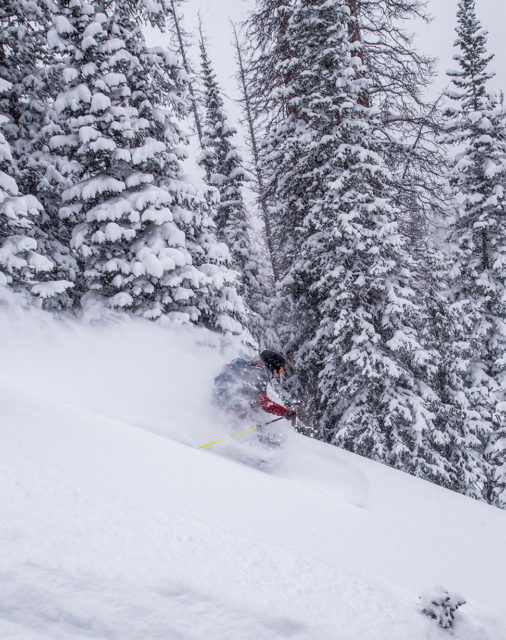
If maximum breathability is your priority, I highly recommend checking out the Patagonia Descensionist or Strafe Cham jackets. The Black Diamond Helio Active Shell and Flylow Cooper also breathe a bit better than the Hemispheres jacket.
But if you have been happy with the breathability of other Gore-Tex shells in the past, the Hemispheres jacket will breathe similarly well.
Warmth
Like most shells, the Hemispheres jacket is not particularly warm. While out touring in the winter, I’ll typically wear a midweight base layer and light mid layer (e.g., Patagonia R1) underneath the Hemispheres jacket.
Freedom of Movement / Range of Motion
With all the hype around the new “Gore-Tex with Stretch Technology,” this was the area where I expected the Hemispheres jacket to excel. And overall, I’d say it does offer a noticeable improvement over most ski shells I’ve used when it comes to not inhibiting movement.
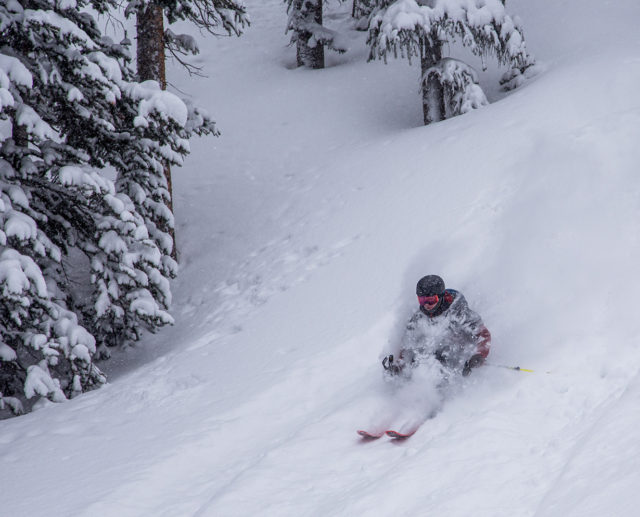
As I noted above, the Hemispheres jacket isn’t particularly baggy or roomy, but because the stretch panels don’t require much force at all for them to stretch / expand, the Hemispheres jacket feels far from restrictive. This was most noticeable while doing normal tasks like bending down to mess with my bindings, reaching into a pack pocket, extending my arms during pole plants, etc.
It is worth noting that, since the stretch panels around the shoulders are positioned to stretch horizontally and not vertically, the Hemispheres jacket still rides up when reaching above my head. Consequently, it wouldn’t be my top pick if you’re into ski mountaineering. I think there’s a lot of potential for this fabric to be useful in climbing shells, where you tend to be contorting your body more and range of motion is more important.
Durability
I haven’t had any durability issues with the Hemispheres jacket after about 15 days of use. The fabric is in great shape and all the zippers, cuffs, drawcords, etc. are all functioning perfectly.
While I was initially a bit worried about the stretch fabric’s durability, I doubt it’ll prove to be much of an issue since the stretch panels are not in very exposed areas.
As always, I’ll update this review if I run into any durability issues as I spend more time in the Hemispheres jacket.
Who’s It For?
I think the Hemispheres jacket makes the most sense for people who ski inbounds and in the backcountry in areas that see a lot of precipitation, where reliable waterproofing is more important than maximum breathability.

It’d make for a great inbounds shell as long as you don’t require a powder skirt, and it can also work as a dedicated backcountry shell if you don’t need best-in-class breathability. And if you want a shell for both? Well, that’s probably where I think the Hemispheres jacket makes the most sense. It has a fit and feature set that I think work well in the resort, but it’s light enough that I don’t mind taking it with me into the backcountry. Just keep in mind that it won’t breathe as well as some shells like the Descensionist, Cooper, and Cham.
On top of that, I think the Hemispheres jacket stands out due to the excellent freedom of movement it offers, despite its fairly “regular” fit. If you don’t like the look and bulk of baggy jackets but don’t want to feel restricted while you’re out skiing, I highly recommend the Hemispheres jacket.
Bottom Line
While its new stretchy Gore-Tex fabric may not be as revolutionary as the original was back in 1969, the Outdoor Research Hemispheres jacket is still a highly functional shell that is worth a look for skiers who prioritize weather resistance and freedom of movement. If you don’t typically ski in heavy precipitation, I’d recommend more breathable shells like the Flylow Cooper or Patagonia Descensionist. But if you want a pretty light, fully waterproof jacket that’s neither bulky nor restrictive, the Hemispheres jacket is worth a look.

Few commments regarding the Gore-stretch fabric:
I don’t know why all the reviews keep saying “new, Gore-Tex with stretch”. I have a 15year old pair of Gore-Tex stretch pants hanging downstairs. The fact that it delaminates rather quickly probably explains why Gore discontinued it after one or two seasons, but the fact remains, it HAS been done before.
Second, can we stop with the “2 way” stretch description for fabrics? It’s confusing. How could something in only 1 direction?
So, if you want to be precise, let’s call it single axis stretch and double axis stretch. I realize the marketing departments don’t like that since it sounds less stretchy, but that what Blister is for right, poking through the marketing?
Again, since this is Blister, I expect a higher standard than all the other reviews of this piece.
Keep up the good work!
Hi Tjaard,
While there have been Gore-Tex fabrics (and other waterproof/breathable fabrics for that matter) that allowed for some degree of stretch, to the best of my knowledge, there has not been a waterproof/breathable fabric that allowed the same degree of stretch as this new Gore fabric. I.e., this new fabric isn’t revolutionary because it stretches, it’s unique because of how much it stretches. That said, I haven’t used any Gore products from 15 years ago, so I can’t speak to the degree of stretch in their older products. But in my experience, I’ve never felt any waterproof fabric that looked, felt, or stretched like this new Gore stretch fabric.
And I just added a note about the stretch in a single axis. I agree that the market’s descriptions of stretch (2-way and 4-way) can be a bit confusing, so I’ll try and make that clearer in future reviews when we discuss a fabric’s stretchiness.
I have not gotten my hands on the new Gore Stretch, but the old was was certainly very stecht. Like you did, I would describe it ass less stretchy than spandex, but similar or better to the stretch Windstopper products I have tried. (Partly because it was a 2 layer laminate)